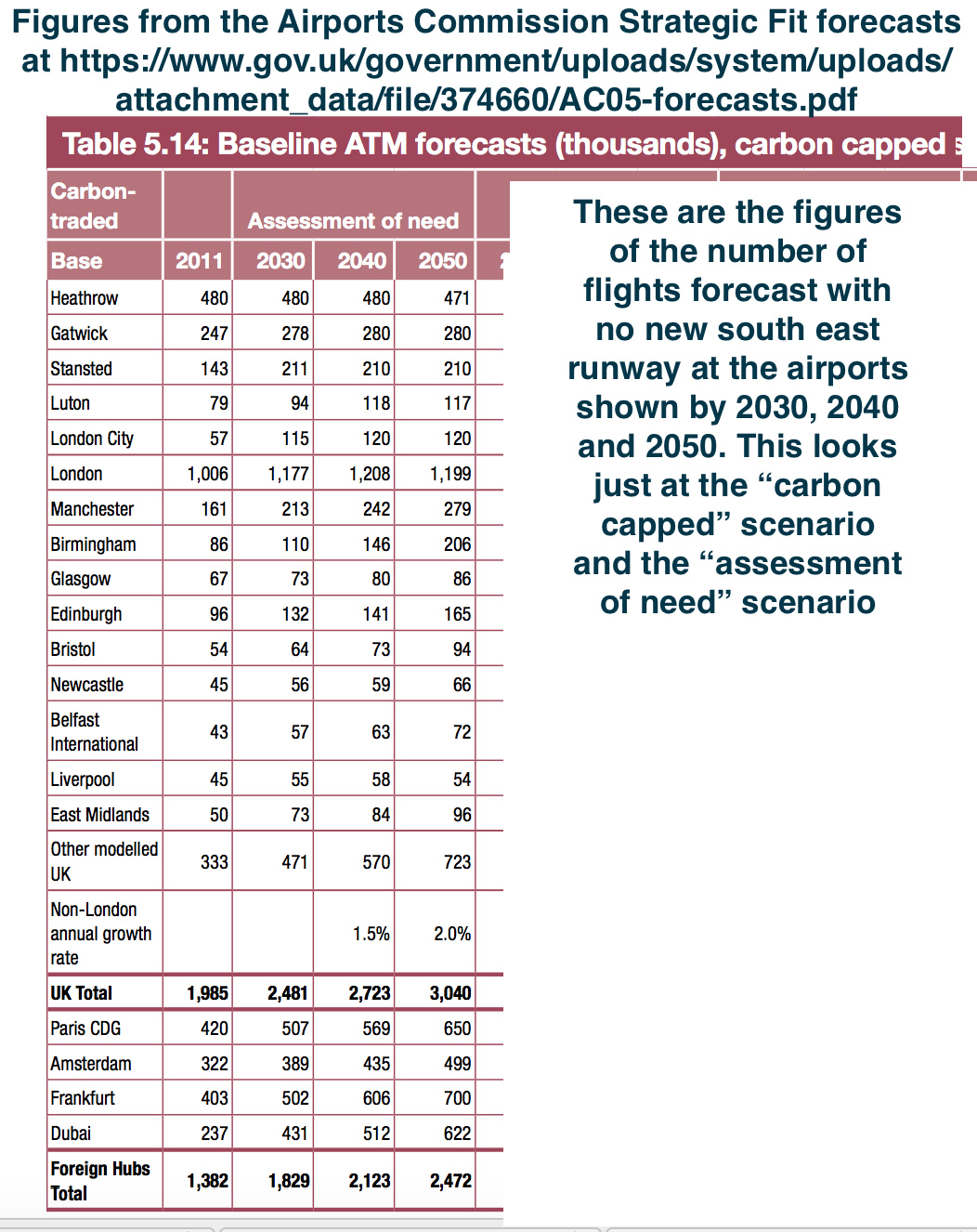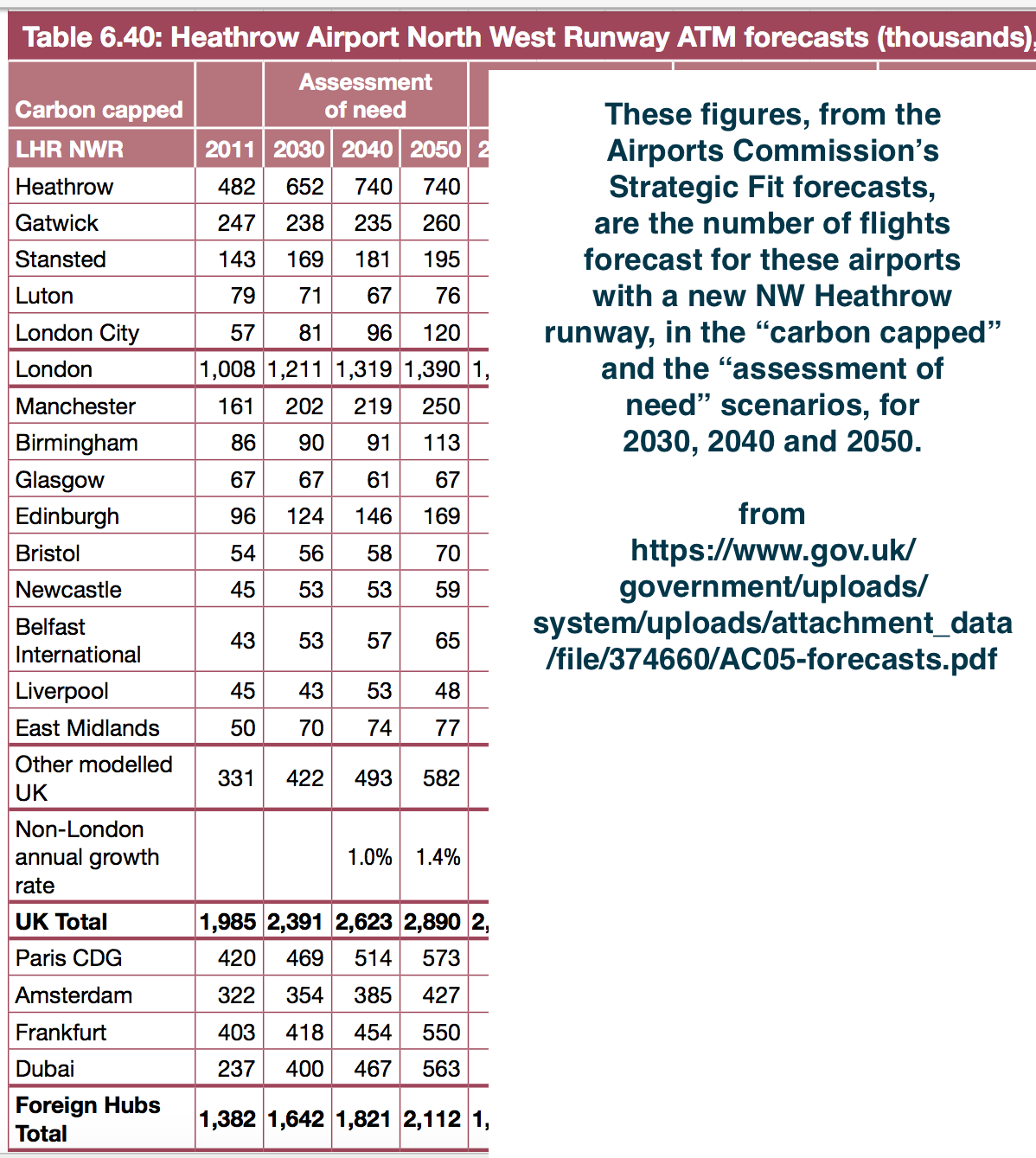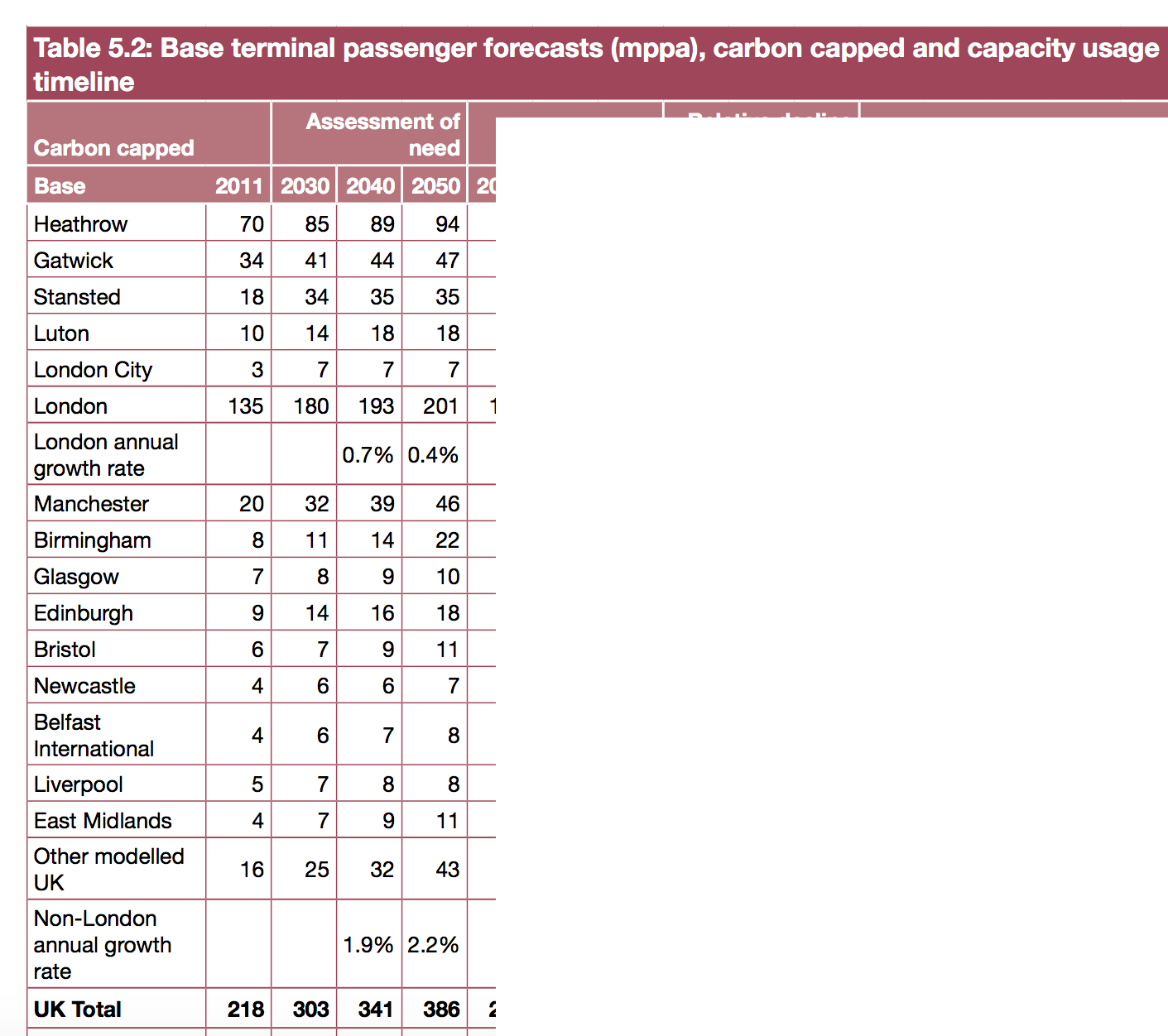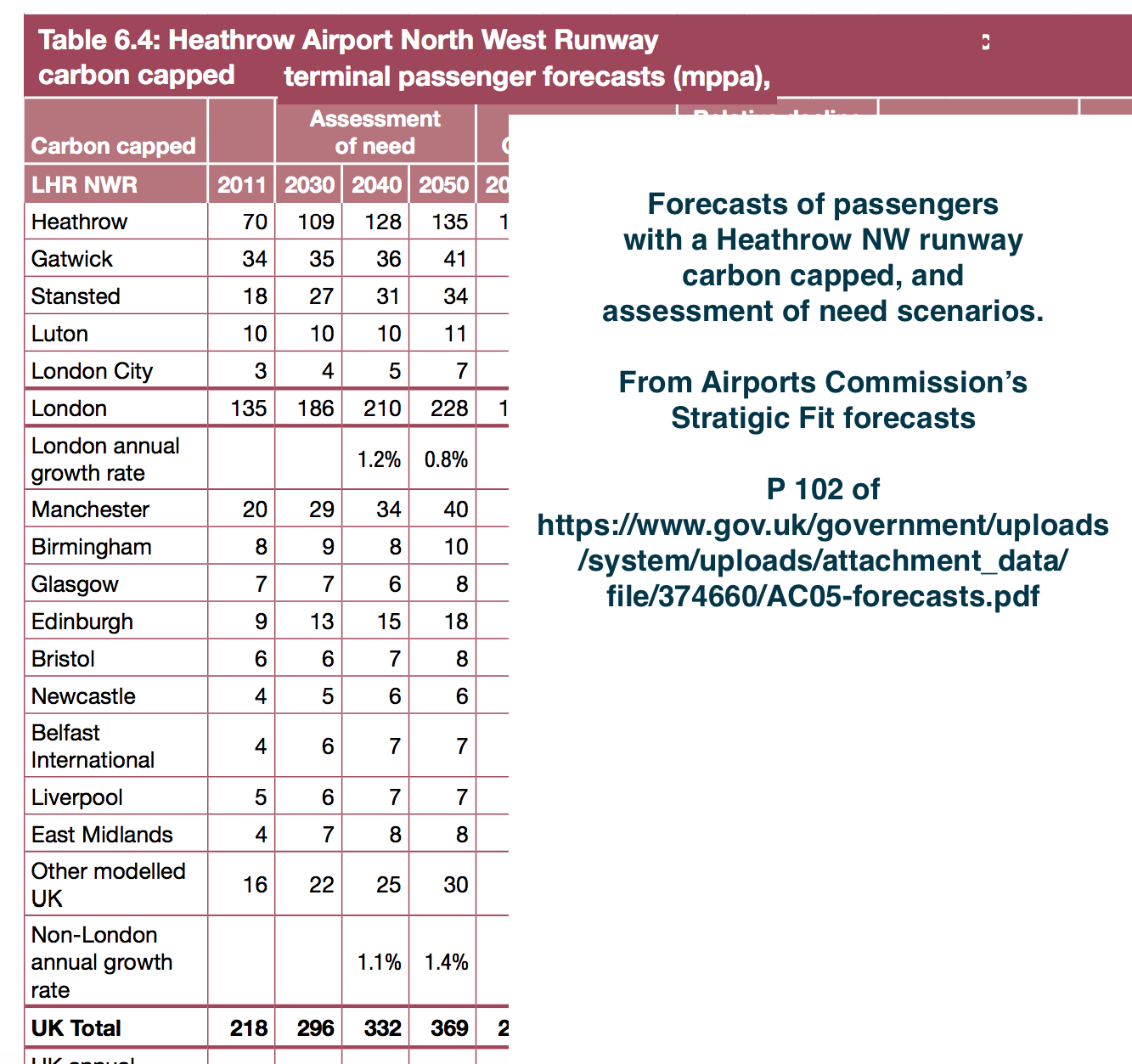RHC Letter to the PM: Contrary to the Airports Commission’s recommendation the Commission’s evidence demonstrates Heathrow should not be expanded
The Richmond Heathrow Campaign (RHC) has done a lot of detailed work, checking through the voluminous details of reports for the Airports Commission. The headline statements by the Commission, with its enthusiasm for a Heathrow northwest runway, are often not in accord with other figures in their documents. The RHC has written both to the Prime Minister and the Transport Secretary, setting out a lot of concerns about a 3rd runway, and facts and figures from the Commission itself that show the case for a runway is very weak. The RHC make the points that adding a new Heathrow runway would be contrary to the Government’s aim for re-balancing the UK economy across the regions, as it can only be done by reducing the market for other UK airports. It would add a very small extra number of long-haul destinations at Heathrow but take these away from regional airports so there is no increase in the number of destinations from the UK, compared to no Heathrow expansion. And it would result in a very high number of international-international transfer passengers using Heathrow, rather than improving air links overall. The RHC say that instead of expanding Heathrow, there is a need to make better use of the capacity of Heathrow and other UK airports and to improve surface access to London’s five airports. The letter is reproduced below and, in support of the evidence in the letter, a schedule linking the letter to the Airports Commission’s evidence is also provided.
.
Tweet
The letter is based on evidence, mostly sourced from the Commission’s report, and accessible on the Richmond Heathrow Campaign websitehttp://www.rhcfacts.org/. The RHC Heathrow Fact Sheets cover 8 topics and in turn link to the Commission’s Report and other references.
The letter can also be viewed on the RHC website at
http://www.richmondheathrowcam
.
RHC letter to Prime Minister 21.7.2016 is copied below. There is also an additional document that sets out all the sources of the figures – so they can all be corroborated.
To
The Rt Hon Theresa May, MP
The Prime Minister
10 Downing Street
SW1A 2AA
.
and
The Rt Hon Chris Grayling, MP
The Secretary of State for Transport
Great Minster House 3
3 Horseferry Road
London SW1P 4DR
From
The Richmond Heathrow Campaign
7 The Green
Richmond
Surrey
Richmond TW9 1PL
21 July 2016
Dear Prime Minister and Secretary of State
Heathrow Expansion
We have studied the Airports Commission’s Report on runway capacity in great depth and are very concerned at the major discrepancies between the Report’s evidence and conclusions. Our detailed analysis clearly demonstrates that additional runway capacity at Heathrow would harm the UK’s status as Europe’s most important aviation hub and it would harm the UK economy and environment. We urge you to take account of the following issues when the Government decides on airport expansion. We think you will be staggered by the evidence not brought to the front by the Commission.
1. Heathrow is not full.
Heathrow operates at its planning limit of 480,000 flights a year in segregated mode. But the Commission’s Report shows there is adequate existing runway capacity to support 33% growth in passenger numbers through use of larger aircraft and higher occupancy (70 million passengers in 2011 rising to 94 million by 2050) or 65% growth in UK terminating passengers, taking account of the Commission’s forecast reduction in International to International transfer passengers, (52 million terminating passengers in 2011 rising to 86 million by 2050).
2. International to international (I-to-I) transfer passengers would be the major beneficiaries of Heathrow expansion but of little or no benefit to the UK.
The Commission forecasts that around 50% of the additional runway capacity would be used by I-to-I transfer passengers (22 million additional transfer passengers out of 42 million additional passengers). Most transfers use the higher frequency routes, e.g. New York. It is largely a myth that I-to-I transfers provide ‘critical mass’ on low frequency routes. In 2011 only 7 long-haul low frequency destinations out of 172 international destinations had any transfers. So, I-to-I transfers do not materially improve UK connectivity. They assist the connectivity of overseas business travellers competing with the UK and they are exempt from air passenger duty. The Commission forecasts 30 million I-to-I transfer passengers by 2050 or 22% of passengers, assuming a 3rd runway. The environmental cost of I-to-I transfers in terms of carbon and noise is proportional to this percentage. The beneficiaries are not the UK but I-to-I transfer passengers, the airlines (around 50% owned overseas) and Heathrow (90% owned overseas). We submit that fewer I-to-I transfers on the most popular routes would free up existing runway slots for new routes around the world and support the 65% growth in terminating passengers forecast by the Commission and referred to in (1), above.
3. Heathrow expansion reduces growth at most other UK airports. It harms competition, local economies and employment and concentrates growth in the over-heated southeast.
The Commission forecasts Heathrow expansion would add 42 million passengers a year at Heathrow by 2050 compared to the Do-minimum case. But it also shows the growth of other UK airports being curtailed by 59 million passengers a year as a result to 234 mppa. Total UK passengers would be reduced by 17 million a year from 386 million to 369 million in 2050, as a result of Heathrow expansion. As examples, the Commission estimates the number of flights in 2050 at Birmingham airport would be reduced from 206,000 to 113,000 (45%) (2011 – 86,000 flights), comparing the Do-minimum case with the Northwest runway expansion option, carbon capped. Growth at Luton would be reduced by 35%, Glasgow: 22%, Bristol: 26%, East Midlands: 20%, Newcastle: 11%, Belfast International: 10%, Liverpool: 11%, Manchester: 10%, Stansted: 7% and Gatwick: 7%. Total UK flights in 2050 would be reduced from 3.039 million to 2.891 million (i.e. by 5%) as a result of Heathrow’s expansion. Heathrow would end up serving 35% of UK passengers with many other UK airports left with substantial unused capacity. This is a negative impact on the UK as an aviation hub and on most UK airports, some of which may not survive, and on local economies and employment. We submit this outcome would work against the Government’s aim of re-balancing the UK economy.
4. Heathrow’s expansion reduces the number of air inbound tourists to the UK.
One of two main economic benefits from air travel is inbound tourism. The Commission forecasts that by 2050 Heathrow expansion would add at Heathrow 4 million foreign resident leisure passengers to/from the UK compared to the Do-minimum case. But there would be losses of 2 million at Gatwick, 2 million at other southeast airports and 7 million in the regions. The net loss to the UK would be 7 million foreign resident leisure passengers (from 59 million passengers a year to 52 million), compared to the Do-minimum case. We submit this would result in a material loss to the UK economy and balance of payments. Inbound tourists spent £22 billion in 2014 and 73% reached the UK by air.
5. The benefit claimed for increased long-haul business passengers resulting from Heathrow expansion is not supported by the evidence.
The second of two main economic benefits from air travel is trade enhanced by long-haul business passengers. The claim by the Commission of the increase in long-haul business travel and its benefit to the UK economy appears not to be supported by any evidence. There is evidence for business passenger numbers and long-haul passenger numbers but not the two combined. The evidence provided in the Commission’s Report and elsewhere suggests the total number of long-haul business passengers (from the UK and overseas) may reduce across the UK as a result of Heathrow expansion, compared to the Do-minimum case.
6. Heathrow’s expansion, compared to the Do-minimum case, results in the number of long-haul destinations from the UK being unchanged and adds only one domestic destination.
The Commission forecasts that expansion of Heathrow would result in the number of long-haul destinations at Heathrow increasing from 92 in 2011 to 98 in 2050 compared to 89 in the Do minimum case. But the number of long-haul destinations across the UK increases from 107 to 130 in both the expansion option and in the Do-minimum case. Therefore, UK connectivity in terms of number of long-haul destinations is not improved by Heathrow expansion. The number of domestic destinations to/from Heathrow is reduced from 7 in 2011 to 3 by 2050 in the Do-minimum case and to 4 with expansion. What does increase is the frequency of flights to already popular destinations, e.g. New York. We submit this increase in frequency is of limited economic benefit to the UK.
7. Heathrow expansion ensures Heathrow is the most expensive major airport in the world.
The Commission forecasts Heathrow’s aeronautical charges to rise from £22.53 per passenger in 2014 to £31.20 with expansion (£ real 2014). This compares with around £9 at Gatwick, £12 at Schipol, £8 at Dublin and Manchester and £11 at New York JFK, for example. Providing support for the inbuilt inefficiency of Heathrow is questionable. The high cost of Heathrow is partly due to the facilities for I-to-I transfers, which in (2) above we submit are of questionable value to the UK.
8. Heathrow expansion may not be financially deliverable without substantial State aid.
The Commission’s base case financial model for Heathrow forecasts capital costs of £80 billion (money of the day), excluding a probable underestimate of up to £15 billion of surface access costs if congestion and air pollution are to be reduced. The £80 billion comprises £25 billion for the Northwest runway expansion scheme, £22 billion for core capital expenditure and £33 billion for replacement capital expenditure, all through to 2050. Peak debt will need to rise from £11 billion in 2014 to £34 billion in 2028, which with re-financing needs will be a huge challenge for debt markets. The shareholders (90% owned overseas) are forecast to raise their capital from £3 billion to £8 billion, which is hardly cushion enough to absorb the substantial construction, operation and financial risks. The passenger and tax payer is left to absorb most of the risk but the former will be heavily burdened with high aeronautical charges leaving the risk to be borne by the UK tax payer.
9. Heathrow expansion and population growth offset improvements in noise climate from less noisy aircraft and in operations, resulting in over 1 million Londoners suffering from Heathrow aircraft noise.
Modernisation of London’s airspace using new technology is in serious doubt because of the community’s resistance to change in overflight and the noise consequences and the unproven noise benefits of introducing multiple flight paths and respite. Redesign is complicated by the substantial forecast growth in London’s population. Heathrow, the DfT, NATS, and the CAA have not yet been able to formulate any meaningful airspace modernisation plans, let alone the far more difficult scenario including Heathrow expansion. To increase the number of flights by 50% probably is impossible in these circumstances and to approve Heathrow expansion without any plans on how the airspace capacity and efficiency can be upgraded is a huge shot in the dark, potentially making the expansion undeliverable. Furthermore, the Government has still to revise the National Aviation Policy Framework, which we agree is urgently needed to establish policy for modernisation.
10. Air Quality around Heathrow is poor mainly due to road traffic and Heathrow has not demonstrated how legal limits can be met.
Expanding Heathrow would increase local air pollution as the number of flights and passenger and staff land based journeys to and from the airport rise. This could affect the health of over 100,000 additional people. Given that existing airport operations already result in a breach of legal air pollution limits, it seems unlikely that a third runway could be built while remaining within the law. Furthermore, the health of people and, particularly the vulnerable, is impacted even when pollution levels are below the legal limit.
11. Heathrow expansion seriously challenges the UK’s Carbon commitments.
In 2009 the government adopted a target to reduce UK aviation emissions back to the 2005 levels of 37.5 million metric tonnes of CO2 by 2050, which would be 25% of the UK’s total CO2. Carbon capping may provide some scope to meet this but would result in re-distributing growth to Heathrow at the expense of the rest of the UK economy. Carbon trading would challenge the rest of the UK economy for limited carbon credits and only be practical if adopted worldwide. There is therefore a risk that Heathrow airport’s growth will be constrained even more than currently predicted in the Airports Commission’s modelling by the impact of carbon emissions, potentially rendering a third runway uneconomic. Alternatively, Heathrow could end up contributing substantially to climate change.
.
We recognise the need to balance the environmental cost and economic benefit were Heathrow to be expanded. The Commission has sought a number of mitigation actions from Heathrow to reduce the environmental cost. We doubt these will have much effect. We show in this letter, based for the most part on the Commission’s evidence, that the economic benefits to the UK of Heathrow expansion are probably negative, especially when including the financial risks borne by the State.
London’s five airports together lead the world. Our approach is to support significantly improved surface access to these airports along with better use of existing capacity at Heathrow and other UK airports.
We would be pleased to provide further detail to the Government. Some assistance can be found at www.rhcfacts.org where detailed references and links to the Commission’s Report can be found.
Yours faithfully Peter Willan, BSc(Eng)Hon, MBA, ARSM, FCMA, FEI, Hon RCM
Chair, Richmond Heathrow Campaign
email: willan829@btinternet.com
.
Link to the sources of the figures used in the above letter
Sources of information RHC letter to PM
Note 1.
The evidence from the Airports Commission’s Final Report July 2015 is that of the Assessment of Need carbon capped scenario used by the Commission as its main approach to long-term forecasts. Heathrow expansion refers to the Northwest runway option and the Do-minimum case is as defined by the Commission assuming no new runways in the UK.
.
Note 2.
The Richmond Heathrow Campaign represents three amenity groups in the London Borough of Richmond upon Thames: The Richmond Society, The Friends of Richmond Green, and The Kew Society, which together have over 2000 members.
.
——————————————————————————————————
A few additional sources for the information in the letter, added by AirportWatch not the RHC;
Details about there being 22 million additional transfer passengers out of 42 million additional passengers. See link
Heathrow’s aeronautical charges to rise from £22.53 per passenger in 2014 to £31.20 with expansion [PwC P41] (£ real 2014).
Heathrow shareholders – 90% owned overseas – see link
The National Aviation Policy Framework see link
In 2009 the government adopted a target to reduce UK aviation emissions back to the 2005 levels of 37.5 million metric tonnes of CO2 by 2050 see link
Heathrow runway’s impact on regional airports
For interest, below are sections of two of the tables from the Airports Commission’s Strategic Fit forecasts document, showing the expected impact on regional airports of building a new Heathrow runway. This shows clearly how much damage building a 3rd Heathrow runway would do to the rest of the UK’s airports (all use the scenarios that the Airports Commission used most, of “carbon capped” and “assessment of need.”
.
Number of flights forecast with no new runways
[It is carbon capped, as it says in the title. There is a mis-print where it says carbon traded. Table 5.13 deals with the carbon traded options).

Number of flights forecast with a new Heathrow NW runway

both taken from “Strategic Fit: Forecasts” Nov 2014
https://www.gov.uk/government/uploads/system/uploads/attachment_data/file/374660/AC05-forecasts.pdf
.
and
Number of passengers forecast with no new runways

Number of passengers forecast with a Heathrow NW runway

.
.
.
.
.
